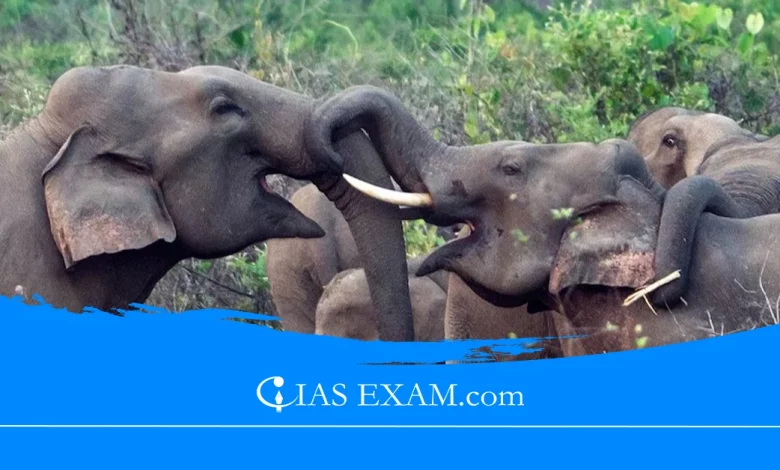Captive Elephant Transfer Regulations
Syllabus: Environment [GS Paper-3]

Context
The government has introduced the new Captive Elephant (Transfer or Transport) Rules, 2024, which make it easier to transfer or transport elephants within or between states.
Details about the Regulations
- In 2024, the Indian government introduced the Captive Elephant (Transfer or Transport) Rules, marking a significant step in the regulation of elephant management within the country.
- These rules, developed by the Union Ministry of Environment, outline specific procedures and conditions for the transfer and transport of captive elephants.
Key Points of the Captive Elephant (Transfer or Transport) Rules, 2024
The Captive Elephant (Transfer or Transport) Rules, 2024, introduced by the Indian government, include several key provisions:
- Authority of Chief Wildlife Wardens: The designated officials have the legal responsibility to determine whether the transportation of elephants between jurisdictions within or outside of states will be allowed.
- Exceptions for Ownership Certificates: The rule for these elephants has the provision for those with the pre-existing ownership certificates. In the zoo, this applies to newborns of such captive elephants but not finally.
- Condition for Transfer Based on Elephant Welfare: As a safety net transfer will be allowed if the current owners find they are no longer able to look after the elephants properly.
- Genetic Profile Recording Requirement: The process of transfer needs to be recorded by observing the elephants’ genetic profiles in the Union Ministry of Environment’s electronic monitoring and database application.
- Application and Inquiry Process: The owners are obliged to file transfer applications individually to the Forest Conservator’s Office. The implicated applications will be subjected to scrutiny of their validity and must be addressed for the Wildlife warden within seven days after which they will be easily issued out.
- Compliance with CITES: The regulation safeguards conformance of these species to CITES rules for species management and creditable acquisition.
- Registration Certificates by Chief Wildlife Wardens: For species covered under CITES, chief wildlife wardens can issue registration certificates and manage legal acquisitions.
Impacts
- Regulatory Oversight: Improved control and scrutiny of the trafficking of elephants could in turn result in better leadership practices in the elephants’ habitat.
- Wildlife Trafficking: Better arrangements like a tighter regulation can make a good fight against illegal trafficking of elephants and in line with CITES.
- Conservation Efforts: Through such rules, the transfers could be subjected to controls which then may improve the conservation strategy especially for the species with low numbers and abundance.
Benefits
- Elephant Welfare: Thereby, the well-being of stronghold animals is the most important factor for the decision making of elephant transfers.
- Genetic Diversity Preservation: Recording of genetic profiles is then maintenance of gene diversity among various groups of elephants kept in captivity.
- Enhanced Accountability: Enforced lifelong care on the part of owners as well as strict regulations for their transfer especially contributes to the transparency in the care of all elephants.
- Legal Compliance: The associated integration of international conservation agreements enables India to fulfil its CITES international commitments.
Captive Elephant
- The elephants mentioned here are not wild but are under human control.
- They are kept for different reasons like education, entertainment, and work.
- These elephants can be seen in places like zoos, sanctuaries, circuses, and camps.
- Cultural and Religious Role: Used in ceremonies and festivals, especially in Asia.
- Tourism and Entertainment: Involved in activities like rides and performances.
- Conservation: Some are part of programs aimed at species preservation.
- Welfare Concerns: Issues with living conditions, health, and ethical treatment.
- Legal Protection: Governed by laws and international agreements like CITES.
- Habitat and Anti-Poaching Efforts: Vital for wild elephant conservation.
- Rehabilitation and Sanctuaries: Facilities dedicated to rescuing and rehabilitating captive elephants.
Conclusion
The Captive Elephant (Transfer or Transport) Rules, 2024, issued by India’s Union Ministry of Environment, govern the relocation of captive elephants, granting authority to chief wildlife wardens to approve transfers when owners are unable to care for them. However, transfers must include the elephant’s genetic information in a monitoring system. While these rules comply with CITES regulations for endangered species, they have faced criticism for potentially undermining wildlife conservation objectives and the suggestions of the Elephant Task Force 2010.
Source: The Hindu
UPSC Mains Practice Questions
Q.Critically Analyse the Effectiveness of the Captive Elephant (Transfer or Transport) Rules, 2024, in Balancing Wildlife Conservation and Cultural Practices in India.





.png)



